Seeing a spike in violations issued by City Agencies, we wanted to help our extended family and friends by ensuring you understand the different kinds of violations issued, how to correct them to avoid further penalties and more importantly, how to prevent violations altogether.
See below for further details.
There are several different types of violations. Such violations include but are not limited to:
- Stop Work Orders (SWO)
- Vacate Orders
- Unsafe Buildings action (UB)
- Criminal Court Summons
- DOB Violations
- ECB Notice of Violations (NOVs)
ECB violations are the most common type of violation therefore will be the main subject of this newsletter. Please contact us directly to assist with the remediation of any type of violation(s) you may have received.
NOVs are issued when a property does not comply with the Building Code, Zoning Resolution or other statute. It is an Order of the Commissioner to correct a condition AND certify correction of that condition. ECB NOVs may result in a hearing at the Environmental Control Board, the administrative tribunal. NOTE: ECB renders decisions and judgments as well as collects all penalties imposed at hearings but do NOT:
- Issue violations
- Establish enforcement policies
- Employ inspectors
- Direct, control or otherwise influence where, when or to whom the violations are issued
Classification of The Violation
- Immediately hazardous – Class 1
- A violating condition that:
- Severely affects life, health, safety, property, the public interest, or a significant number of persons
- Warrants immediate corrective action
- For outdoor advertising, where the penalty is needed as an economic disincentive to the continuation or repetition of the violation
- NO CURE, NO STIPULATION, NO MITIGATION
- MANDATORY HEARING
- PENALTY RANGE: $1,000 to Maximum $25,000
- Note: Class 1 daily penalties for Class 1 illegal alteration are $1,000 per day for maximum of 45 days
- A violating condition that:
- Major violation – Class 2
- Violating condition affects life, health, safety, property, or the public interest, but does not require immediate corrective action or with respect to outdoor advertising where the violation and penalty are appropriate as an economic disincentive to the continuation or the repetition of the violating condition.
- Most are eligible for CURE, STIPULATION and MITIGATION
- Some hearings are mandatory
- Penalty range from $0 to $10,000
- Lesser violation – Class 3
- Where the violating condition has a lesser effect than an immediately hazardous violation (Class 1) or major violation (Class 2) on life, health, safety, property, or the public interest.
- ALL are eligible for Cure, Stipulation and mitigation
- Hearings NOT mandatory
- Penalty Range: Maximum $500
“Cure”
- Available on certain violations (Class 3 and most Class 2)
- Respondent corrects the violating condition AND certifies correction within 40 days of service of the violation
- IF DOB’s Administrative Enforcement Unit (AEU) finds the certification acceptable:
- Respondent has admitted the violation
- No hearing appearance necessary
- ZERO PENALTY imposed
- If not submitted and approved before the cure date the respondent must attend the hearing
“Stipulations”
- Available for certain violations (Class 3 and certain Class 2)
- Admission of the violating condition
- Extends time to file a certificate of correction by an additional 75 days from the first scheduled hearing date
- May be accepted by mail (5 days before hearing date) or at ECB on day of the hearing; Penalty is mitigated or one-half the approved penalty
- Full Board approved penalty will be imposed if the NOV is not certified as corrected within 75 days of the first hearing date (on the NOV)
Defaults
- Respondent “in-violation” and the maximum penalty imposed
- Request to vacate defaults are addressed to ECB and are time sensitive
- Vacating a default is an ECB Decision.
Why Certify Correction?
- Required by Law – Order from Commissioner to correct violation and submit certification
- Additional violations and civil penalties can be issued for not certifying correction
- Violations remain “open” until certification received and BISWeb is updated to indicate compliance
- Banks, mortgage, title companies review BISWeb for compliance information
- Re-inspections of uncorrected violations may result in additional violations and higher penalties
- Failure to certify can affect ability to obtain a Certificate of Occupancy
- Agreed to by Stipulation
How to Certify Corrections
- DOB’s AEU accepts certification submissions at any time after any violation is issued and entered into the BISWeb
- All Class 1 and some Class 2 violations may NOT be “cured” but will still need to be certified corrected
- All violations corrected after the “cure” date (if applicable) must attend the ECB hearing and pay the applicable penalty
Tips to Avoid ECB Violations
- Comply with the Code
- Obtain permits and maintain in a conspicuous location
- Work within the scope of the permit and be sure that DOB approved drawings are on site at all times
- Hire Registered/Licensed Professionals
- Correct Outstanding Violations
- Uncorrected violations may lead to additional violations and hefty penalties for Class 1 violations
- Perform Regular or Scheduled Maintenance on Buildings and Appurtenances with clear documentation
- Local Law façade/boiler/elevator filings
- Maintenance of structure etc.
- Stay Current with New Requirements

